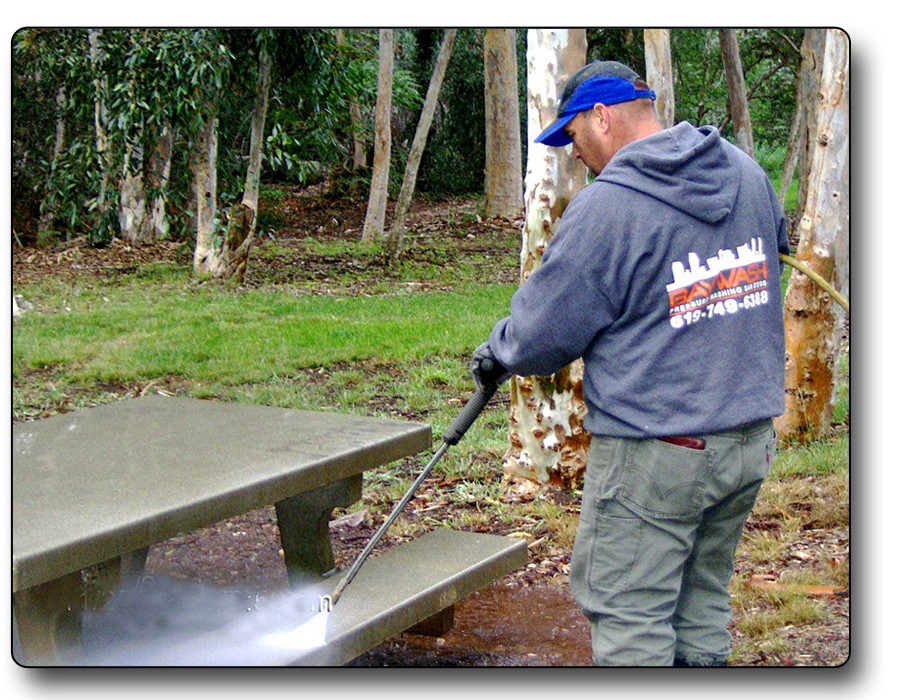
Outdoor public spaces—whether city parks, school yards, or plazas—offer a place for people to gather, eat, relax, or socialize. But with regular use comes regular mess: spilled drinks, bird droppings, food stains, chewing gum, sticky residues, and even graffiti. 🧃🐦🍔
To maintain a clean and inviting environment, power washing is one of the most effective methods for keeping picnic tables, benches, and other seating areas spotless and safe. When done properly, it can improve hygiene, extend the life of furnishings, and enhance the overall experience for visitors.
This guide covers how to pressure wash outdoor seating areas the right way—without causing damage or disrupting the public space.
🪑 Types of Outdoor Seating You May Encounter
Understanding the material is essential before applying any pressure:
- Wooden benches and tables (treated, painted, or untreated)
- Plastic or resin picnic tables
- Metal seating (steel, aluminum, cast iron)
- Concrete benches or table bases
- Composite or recycled material furniture
Each material handles pressure differently, so always match your PSI and nozzle to the surface you’re working with. Overdoing it could lead to splintering, etching, or paint damage. ⚠️
🧰 Supplies and Tools You’ll Need
To do the job efficiently and safely, gather:
- Pressure washer (2,000–3,000 PSI is sufficient for most surfaces)
- 15° and 25° nozzles (sometimes 40° for delicate areas)
- Biodegradable outdoor cleaner or degreaser
- Gum scraper or putty knife
- Stiff-bristled brush
- Bucket of water
- Protective eyewear and gloves
- Signage or caution tape (to block off areas temporarily)
🧽 Optional: A leaf blower or wet/dry vacuum can speed up drying.
Browse Amazon Here For Top Rated Power Washers And Accessories
🧼 Step-by-Step: How to Pressure Wash Public Seating Areas
1. Prepare the Area
Clear away trash, debris, and any personal items left behind. Use signage to block off the area or politely alert people nearby. You want a safe, distraction-free work zone.
Remove table umbrellas, trash bins, and any accessories that could obstruct access.
2. Scrape Off Gum and Sticky Residue
Public seating is a magnet for chewing gum, spilled sugary drinks, and other gunk. Use a scraper or putty knife to remove visible stuck-on debris before applying pressure. This helps avoid splattering and saves time later.
3. Pre-Treat with Cleaner
Apply a biodegradable outdoor cleaner to tabletops, seats, and bench backs. Focus on greasy areas, graffiti, bird droppings, or sticky zones. Let it sit for 5–10 minutes to break down the grime. 🧴
Avoid harsh chemicals like bleach in areas near grass, plants, or drainage systems.
4. Choose the Right Nozzle and Pressure
Use a 25° nozzle for general surfaces and a 15° nozzle for tougher spots like gum stains or graffiti on concrete. For plastic or painted wood, go with a 40° nozzle and dial the pressure down.
Start by holding the wand 12–18 inches away, adjusting closer only as needed.
5. Spray with Consistent Overlapping Strokes
Clean each table or bench from top to bottom, allowing the water and loosened dirt to flow downward. Overlap strokes for even cleaning, and don’t pause too long in one spot to avoid leaving marks or gouges.
Focus areas:
- Tabletops and seats
- Undersides and legs
- Backrests and armrests
- Pavement around the furniture
⚠️ Common Mistakes to Avoid
❌ Too much pressure on painted wood or plastic surfaces—this can chip or gouge the surface.
❌ Using hot water on plastic or composite furniture—it can warp or melt the material.
❌ Power washing in public during peak hours—risking splash-back on passersby.
❌ Ignoring runoff—always direct wastewater away from drainage-sensitive areas.
📆 How Often Should You Clean Public Seating?
Cleaning frequency depends on usage:
- High-traffic parks or plazas: Weekly to bi-weekly
- School yards or community centers: Monthly or after large events
- Seasonal outdoor dining areas: At the start and end of the season
- Rest stops or roadside areas: Monthly or as needed
Adding power washing to a regular maintenance schedule keeps everything looking fresh—and visitors appreciate clean surroundings more than you’d think. 💯
💡 Extra Tips for a Longer-Lasting Clean
✅ Apply a UV-protective or water-resistant sealant to wooden or concrete surfaces after washing.
✅ Encourage sanitation with visible trash cans nearby.
✅ Schedule washing during early morning hours to minimize disruption.
✅ In colder climates, avoid washing during freezing temps to prevent cracking or icing.
If your public space suffers from regular misuse or graffiti, installing security cameras or signage can help deter vandalism, which reduces cleanup needs in the long run.
🧽 When to Call a Professional
While most cleaning staff can handle light-duty power washing, you might need a pro if:
- You’re dealing with graffiti or heavy gum buildup
- The furniture is fragile or antique
- You need to clean a large number of benches or tables across a wide area
- City ordinances require proper wastewater collection or reclamation
- Surfaces are close to delicate landscaping or storm drains
Professional pressure washing companies often use low-flow recovery systems and know how to meet local runoff regulations—especially important in public spaces.
🏞️ Final Thoughts
Clean seating areas say a lot about your public space. Whether you manage a city park, a school, or a commercial courtyard, regular pressure washing keeps your benches and tables inviting, sanitary, and looking their best. 🌟
By using the right tools, nozzles, and cleaners—and applying care to each surface—you’ll protect your outdoor investments and leave a lasting impression on your visitors. Plus, it’s just plain satisfying to see those grimy benches sparkle again! ✨🧼🪑
Browse Amazon Here For Top Rated Power Washers And Accessories



